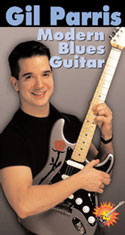
When I first spoke to Gil Parris about reviewing his "Hot Licks" instructional guitar video, "Modern Blues Guitar", I brashly swore I would steal every lick to become "Gil Jr." But like the ancient Greek legend of Icarus, I flew too close to the sun. After viewing a few minutes of Mr. Parris' monstrous technique, I decided to focus on Mr. Parris' philosophical overview rather than the actual notes. Produced and directed by Arlen Roth, this 45 minute work out features the Kip Sophos (bass), Rudy Feinauer (drums), and Phil Magallanes (keys) as well as a booklet including all the music examples written in standard form as well as tablature.
Although the "blues" colors Gil Parris' music, "jazz" actually informs it. While he can solo on changes with the best of them, Mr. Parris really shines when playing "out" on relatively simple chord patterns. Take the opening tune, which sounds suspiciously like "Ain't No Sunshine," -- but without the melody line (LOL!) Though the song contains only three chords (Am, Dm, and Em), Mr. Parris takes you on a journey through a landscape of notes and sounds you never knew existed. Most of Gil Parris' ideas stem from other instruments -- pedal steel guitar, piano, and sax. He excels in applying country sounds to a jazz and blues idiom. He breaks down every lick along the way using the main screen for his left hand and a split screen for his right.
The video follows a straight forward pattern. First, Mr. Parris explains the inspiration behind a set of guitar techniques. Then he demonstrates the licks. And finally, the band performs a tune that showcases this particular bag of tricks. First up, he talks about string bends and how the pedal steel inspired him. Other approaches include bending one note into another, bending up and then down, and the Albert King method of putting a bend within a bend.
Next, Mr. Parris concentrates on the right hand. To obtain maximum dynamics, he alternates between using a pick and his fingers (Travis style and banjo rolling). He takes great delight in exhibiting how he palms the pick. A little like Carmen Appice (Vanilla Fudge, Rod Stewart) twirling his drumsticks.
The great saxophonist Hank Crawford inspired Gil Paris with his tonal skips and leaps. On guitar, Mr. Parris accomplishes this with hammer-ons, pull-offs, and octave displacement. Working with Michael Brecker prompted him to develop an atonal-chromatic scale with false fingering to immitate the false notes of the sax. Finally, he demonstrates traditional chord comping with a walking bass line.
In his low-key style, Gil Parris zeroes in on a number of key musical points along the way. He talks about the importance of developing one's own style. No one wants a copy when they can get the original. He stresses dynamics. "Subtleties make all the difference." As Arlen Roth says, "It's where you fit the notes in the bar." Accoring to Mr. Parris, "Being melodic separates the men from the boys." "Listening is very important."
Although I originally wanted to learn all of Gil Parris' licks, I ran into some difficulties. Number one, I mostly play with a pick and not my right-hand fingers. And number two, I injured my left-hand pinky a number of years ago and can only use it in a limited fashion. Most of Mr. Parris' techniques require each of the fingers on the left hand to cover one fret.
Like the late Chet Atkins, many guitarists today enjoy playing in different idioms -- genre hoppers. They know how to mix them up or keep them separate, depending on the gig. Currently, you can watch Gil Parris perform danceable rock and r&b at Pete's Saloon in Elmsford, NY on the last Friday night of every month. You can also see him play straight jazz at The Thataway Cafe every Thursday night of the summer.
If you long to expand your bag of tricks and take your playing in a whole new direction, buy this video. Gil Parris' unique stylings and concepts will kick start you on a wonderful trip to the center of your musical core.
©2005 Roger Zee